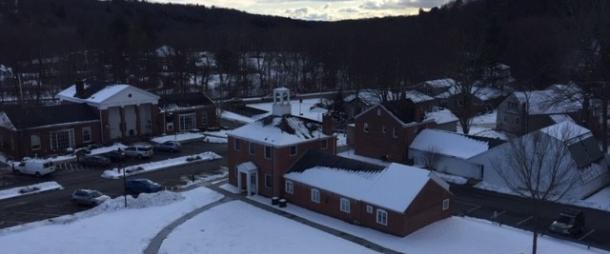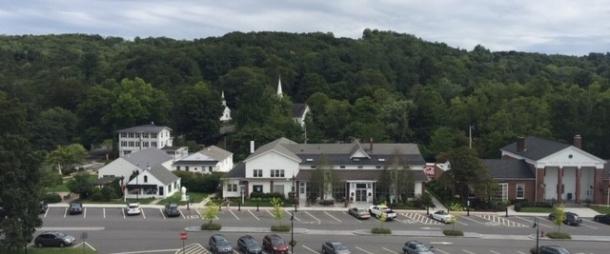Housing in Washington, 2005
What is "Affordable"?
Connecticut Statutes consider a housing unit to be affordable if:
- it is deed-restricted by a legal covenant requiring it
- to be sold or rented at or below prices
- that will preserve it as housing for which persons and families pay 30 percent or less of their annual income,
- where such income is less than or equal to 80 percent of the area's median income (or the state median income, if it is less).
For example, in fiscal year 2005, the median income for a four-person household in the Danbury area (of which Washington is a part) is $96,500. Assume that a household had income of 80 percent of that amount: $77,200. Housing for this household would be affordable if they did not have to spend more than $23,160 (30% of $77,200) for it annually.
What Washington Offers Now
Washington's affordable housing stock (as reported to the State of CT) consists of:
| Location | Units |
| Dodge Farm (rentals on Brinsmade Road) | 14 |
| Riverwoods (senior rentals, River Road) | 12 |
| 16 Church Street (rentals in New Preston) | 11 |
| 4 homes financed by CHFA/FmHA mortgages | 4 |
Of the 37 units at Riverwoods, Dodge Farm, and 16 Church Street, 73 percent of those units are occupied by folks with a Washington connection: they either work here or lived here before or have family who live here. Two volunteer firemen and a teacher live at 16 Church Street. 7 families who formerly lived at Dodge Farms, went on to purchase their own homes.
Connecticut's Affordable Housing Appeals Act
Private developers may also build affordable housing in Washington. They can do so, without having to satisfy local zoning regulations, by taking advantage of a 1989 Connecticut statute, the Affordable Housing Appeals Act.
Maybe as good a way as any to explain the impact of this law is to start by saying that Connecticut's towns hate it. Every legislative session some of them try to get it repealed or weakened.
Why? Because the Act robs local zoning commissions of their authority; it renders them powerless.
That's what the State Legislature intended. It passed the law back in 1989 to combat so-called "exclusionary zoning" at the local level. The legislators believed that zoning commissions were using local regulations (e.g., those prescribing minimum lot size or limiting density) as an excuse to block undesirable affordable housing.
So the Legislature did an end run around local zoning commissions. Under the 1989 Act, a developer still has to apply to a zoning commission for permission to construct any housing development. But, if that development contains at least 30 percent affordable housing, and it is turned down by the commission, then the developer can appeal to state superior court, where the 1989 Act stacks the deck in his favor in at least four ways:
- The burden is on a zoning commission to justify its denial. This represents a complete reversal of the usual burden of proof, which would customarily be on the developer, not the commission.
- That burden is heavy. The zoning commission is required to prove that its denial was necessary in order to protect some substantial public interest in health or safety, which outweighs the need for affordable housing. Such public interests are usually limited to the essentials:
- inadequate water supply
- inadequate sewage disposal, and
- fire safety.
- A commission will always lose in court if it relies merely on the indisputable fact that a developer's proposed housing would violate local zoning laws. Courtsincluding the Connecticut Supreme Courthave repeatedly brushed such violations aside as being no justification for denying affordable housing applications.
Other reasons for denial that have been thrown out in court include:
- exceeding density requirements
- preservation of neighborhood character
- adverse impact on school enrollment
- adverse impact on town finances
- violation of existing Plan of Development
- increased traffic congestion and
- adverse aesthetic impact.
None of these amounted to a substantial public interest in health or safety that outweighed the need for affordable housing.
- When a zoning commission loses an affordable housing appealas they do most of the timethe 1989 Act empowers the court to grant whatever remedy it will take to make the affordable housing development workwithout regard for any local zoning requirements. In other words, state judges are empowered to second-guess local zoning commissioners.
Moratorium from the 1989 Act
Connecticut towns can seek shelter from the impact of the Affordable Housing Appeals Act. If 10 percent or more of a town's housing stock is "affordable," then the town is exempt from the Act. No developer can bully the town anymore.
Washington is nowhere near the 10 percent threshold. Only 1.7 percent of Washington's units qualify as "affordable."
Washington might possibly, however, qualify for a four-year moratorium, during which developers could not use the 1989 Act against the Town.
To qualify for this protection, Washington will need to earn itself 75 "housing equivalent points." Under the 1989 Act, towns can earn varying point scores depending on the number and affordability of their housing units. For example, a senior rental unit is worth a half point; while 1.5 points will be earned for each family rental unit for people whose annual income is 80 percent or less of the median income.
As of 2005, Washington has 47.5 housing equivalent points:
| Location | Points | |
| Dodge Farm: | 14 units @ 1.5 points | 21.0 |
| Riverwoods: | 12 units @ 0.5 points | 6.0 |
| 16 Church St.: | 11 units @ 1.5 points | 16.5 |
| 4 CHFA/FmHA mortgages: | 4.0 | |
The seven units owned by the First Congregational Church at Ellsworth Apartments, though affordable, do not count, because they are not currently deed-restricted to insure their continued affordability. (10.5 points)
As of 2005, state-defined affordable housing represented 1.7% of the total housing stock (30 of 1764 units) of the town. Thus, Washington is 27.5 points short of qualifying for moratorium protection from the 1989 Act.
It is worth noting that a moratorium is by no means a panacea. Even if Washington were to qualify for a moratorium, the Town would not be totally immune from the 1989 Act for four years. That's because a moratorium does not protect a qualifying town from every kind of affordable housing development. For example, a developer with a project containing 40 or fewer units would still be able to invoke the 1989 Act even though Washington was in the midst of a moratorium.
Andrew Shapiro
2005












